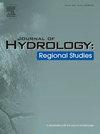What role does agriculture play in irrigation water footprint consumption? A perspective based on sectoral linkage and structural path
IF 4.7
2区 地球科学
Q1 WATER RESOURCES
引用次数: 0
Abstract
Study region
China
Study focus
This study employs a novel three-module analytical framework to appraise the linkage effects and structural paths associated with the irrigation water footprint in the agricultural sector from 2002 to 2020.
New hydrological insights for the regions
The results showed that a) The agricultural sector exhibits a significant reliance on its own internal water resources, while simultaneously representing a critical source of water resources for other sectors, thus positioning agriculture as a net water resource provider. b) Different from the overall irrigation water footprint, which is upward and then downward, the irrigation water footprint in agriculture is characterized by a downward and then oscillating upward. In addition, the net input irrigation water footprint turned from negative to positive highlighting the significant role of imported water in reducing domestic water scarcity. c) An in-depth analysis of agriculture indicates that direct consumption constitutes the largest component of the irrigation water footprint, with outflow significantly exceeding inflow. From a production standpoint, agriculture and industry represent the primary intermediate consumers of the irrigation water footprint. From a consumption perspective, while the structural paths of the irrigation water footprint vary across different consumers, agriculture consistently functions as the initial sector in irrigation water footprint transmission. These findings provide valuable insights for developing nations to develop effective water management strategies in their respective agricultural sectors.
农业在灌溉水足迹消耗中扮演什么角色?基于部门联系和结构路径的视角
本文章由计算机程序翻译,如有差异,请以英文原文为准。
求助全文
约1分钟内获得全文
求助全文
来源期刊

Journal of Hydrology-Regional Studies
Earth and Planetary Sciences-Earth and Planetary Sciences (miscellaneous)
CiteScore
6.70
自引率
8.50%
发文量
284
审稿时长
60 days
期刊介绍:
Journal of Hydrology: Regional Studies publishes original research papers enhancing the science of hydrology and aiming at region-specific problems, past and future conditions, analysis, review and solutions. The journal particularly welcomes research papers that deliver new insights into region-specific hydrological processes and responses to changing conditions, as well as contributions that incorporate interdisciplinarity and translational science.
 求助内容:
求助内容: 应助结果提醒方式:
应助结果提醒方式:


